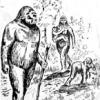I just got back from an exploratory trip to the Mogollon Rim in Arizona.
I split my trip into 2 three day camping trips. First section of trip was not BF related, but the second portion was to explore an area that I have never visited (Mogollon Rim northeast of Payson).
Based on the SSR Bigfoot reports map below, I targeted to explore the area around Bear Canyon Lake and Knoll Lake.
I and a colleague spent one night near Bear Canyon Lake (first photo) and 2 nights near Knoll Lake (2nd photo). These lakes are man-made (both got dams) and are very popular for fishing. Saw lots of people camping in both places the first week of June. On the last day we swung by Woods Lake and it was a zoo of people. My guess is that these Forest Lakes are very popular for folks in Phoenix who are trying to avoid the summer heat and want to do some fishing.
Protocol was to hike during the day on abandoned jeep trails and look for tracks or signs. We did limited off-trail hiking to explore some of the canyons. At night, we hiked 2-3 miles into some of these abandoned jeep trails – mainly to better listen to the wildlife and avoid noise from other campers.
We heard owls, nighthawks, and other birds that I don’t have the knowledge to categorize.
We did not hear any coyotes at night.
We saw 2 white tail deer and the skeleton of an elk (probably left by hunters?).
We also ran into a dead deer and saw the cougar that killed it (see story below).
We saw plenty of deer and elk footprints and scat.
We saw no bear or bear scat.
We saw no BF footprints nor we heard any anomalous sounds (day or night) while we were there.
My Thermal Imager paid for itself on this incident
The first night near Bear Canyon Lake, we decided to walk down an abandoned jeep trail that headed north from the lake parking lot and followed Bear Canyon all the way north. This jeep trail is not shown on the topo map. See topo map below with the purple line showing approximately where the trail is. I wanted to explore it because it followed the canyon closely and I figured many animals will be going down to the canyon for water. Also, this trail passed by a power line and was close to quarry (common features of areas with BF presence).
We hiked about 1.8-2.0 miles north and headed back around 9:30 PM. On the way back, at about 0.5 mile from lake parking lot (~10 PM), we both saw eye-shine to our right up the hill. (We were using regular white light flashlight and not following the BFRO rules of red-light in order to avoid tripping and falling). We clearly saw 2 eyes but they were not moving. I got my thermal imager out of the bag and set it on white hot with red hot for picking up above average thermal signature. We picked up two red hot signatures that were not moving – one medium size and one small. (The small one was a hot rock). I gave my thermal imager to my colleague and told him to scan the area while I was going to walk to the medium size target to see what it was. The target was about 30-40 ft away up the hill and I could not tell what it was with thermal or flashlight. When I got within 10 ft of it, I shined my flashlight and clearly saw a small dead deer (looked like a fawn). I told my friend that I was going to get closer to take a photo when he said there was a bigger red hot target above me that was moving. Then he said it was a cougar and to get the out of there quickly. The cougar was about 30-40 ft from me per my friend’s assessment. I quickly retreated and took back my thermal imager to see what he was seeing and indeed saw a large 4 legged creature moving sideways (not towards us). We quickly packed up our gear and left.
That deer must have been killed recently because its signature was just as hot as the cougar. We did not hear any struggle of the deer (on the way north or south). Even when the cougar was moving, there was no noise. I believe that had we not had the thermal imager, I would have gotten closer to the dead deer and taken that picture and maybe the cougar would have protected its food.
Lessons learned for me, when hiking at night:
- Look for eye-shine (left and right of trail) as you are hiking
- Keep your thermal imager ready to better detect wildlife
When I camp solo, I usually do not hike at night and stay put at campsite. But in this case, my colleague and I wanted to explore at night.
There are risks when hiking at night and we humans have the disadvantage.



